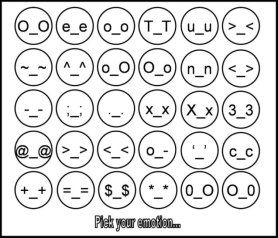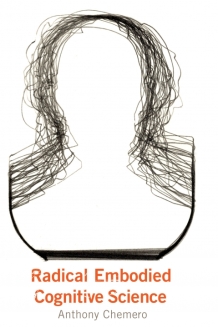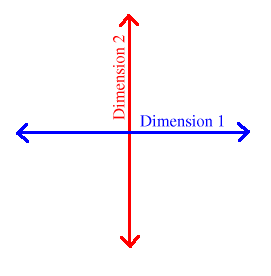Our next E-Intentionality seminar is this Thur sday, December 1st, at 13:00 in Freeman
sday, December 1st, at 13:00 in Freeman
G22. This will be a dry run of a talk I’ll be giving
as part of EUCognition2016, entitled “Architectural Requirements for Consciousness”. You can read the abstract here, along with an extended clarificatory discussion prompted by David Booth’s comments.
Tag Archives: representation
How we represent emotion in the face: processing the content of information from and to the environment
The next E-Intentionality meeting will be Thursday, October 27th in Freeman G31. Please note that David has offered to take preliminary comments in advance via email (D.A.Booth@sussex.ac.uk).

fonzu.deviantart.com
David Booth – ‘How we represent emotion in the face: processing the content of information from and to the environment’
This talk briefly presents an experiment which illustrates the scientific theory that embodied and acculturated systems (such as you and me) represent information in the environment by causally processing its content in mathematically determinate ways. Three colleagues stated the strengths of emotions they saw in sets of keyboard characters that (badly) mimicked mobile parts of the human face. The mechanisms by which they rated the emoticons are given by formulae constructed deductively from discrimination distances between the presented diagrams and the memory of their features on occasions when a face has signalled the named emotional reaction to a situation. Five of the basic formulae of this theory of a mind have structures corresponding to classic conscious psychological subfunctions such as perceiving, describing, reasoning, intending and ’emoting’, and one to unconscious mental processing. Each formula specifies the interactions among mental events which, on the evidence, generated my colleagues’ answers to my questions. The calculations are totally dependent on prior and current material and societal affordances but say nothing about the development or ongoing execution of the neural or linguistic mechanisms involved, any more than do attractors, connectionist statistics or list programs. Functional accounts calculate merely amounts of information or other probabilistic quantities. Distinguishing among contents is equivalent to causal processing. Hence the plurality of mental, cultural and material systems in persons may accommodate a causation monism.
The Two Dimensions of Representation: Function vs. Content
Jonny Lee: The Two Dimensions of Representation: Function vs. Content
The concept of mental representation features heavily in scientific explanations of cognition. At the same time, there is no consensus amongst philosophers about which things (if any things) are mental representations, and in particular how we can account (if we can) for the semantic properties paradigmatic of ordinary representation. In this paper I will discuss a recent development in the literature which distinguishes between the ‘function’ and ‘content’ dimension of mental representation, in an attempt to cast light on what a complete account of mental representation must achieve. I will argue that though the distinction is useful, chiefly because it shows where past philosophical projects have erred, there remain three “worries” about prising apart function and content. In elucidating these worries, I point to the possibility of an alternative to a traditional, essentialist theory of content, one which says that content comes part and parcel of how we treat mechanisms as functioning as a representations.
What is represented in a representation?
 …and by what mechanism were those contents generated?
…and by what mechanism were those contents generated?
Nicola Yuill (nicolay@sussex.ac.uk) is coordinating a reading group on embodied cognition, currently meeting weekly to discuss Tony Chemero’s book Radical Embodied Cognitive Science.
Some people who could not get to the meetings have been circulating comments via the email list, but it was decided that the PAICS blog might be a better home for this discussion. To start things off, below please find a comment from Simon McGregor, David Booth’s reply, etc.
Inference to Representation: Scientific Explanation & Two Kinds of Eliminativism
The first EI of term (Feb 12th, 12:00-12:50, Pevensey 2A11) will be led by Jonny Lee:
Inference to Representation: Scientific Explanation & Two Kinds of Eliminativism
Representation features heavily in scientific explanations of cognition. The principle of ‘inference to the best explanation’ (IBE) says that we ought to believe that our best theories are true. If our best theories feature representations then, according to IBE, we ought to believe that those ascriptions are true. At the same time, eliminativism about mental representation remains popular. In its various forms, eliminativism holds that we ought to reject talk of representation in some or all of cognitive science. How do we reconcile the fundamental role of representation in cognitive science with the continued appeal of eliminativism? In beginning to answer this question, we must understand the different motivations belonging to distinctive kinds of eliminativism. There is more than one kind of eliminativism, and the conflation of these kinds leads to conceptual confusion. I will argue that there is an important distinction between a priori and a posteori eliminativism, and furthermore that a priori eliminativism faces serious obstacles in establishing itself as a persuasive challenger to the status quo. I will finish by considering the possibility that the ontology of mental representation could turn out to be more nuanced than philosophers have previously allowed for.

